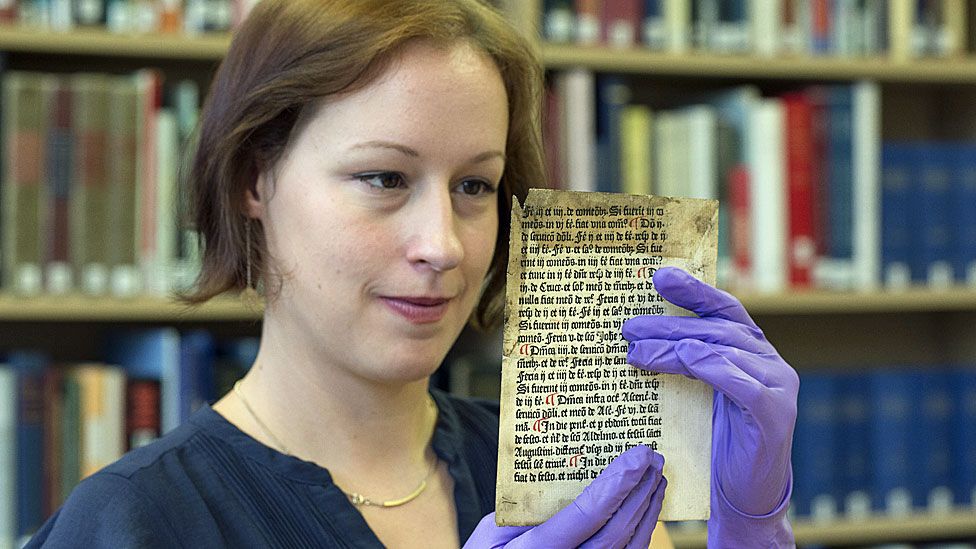'Incredibly rare' William Caxton print discovered
- Published

Pages printed more than 500 years ago by William Caxton, who brought printing to England, have been discovered by the University of Reading.
There are no other known surviving examples of these two pages anywhere in the world, from a book believed to have been printed in London in the 1470s.
The pages had been "under their noses" unrecognised in the library's archives.
Erika Delbecque, special collections librarian at the university, described the find as "incredibly rare".
The two pages, with religious texts in medieval Latin, were produced by Caxton at his pioneering printing works in Westminster - and are now going on public display for the first time since they were sold from his print shop in the 15th Century.
They are believed to be from the earliest years of Caxton's printing press, either 1476 or 1477, and are being hailed as a remarkable discovery.
The only other pages from this book known to be in existence are eight leaves held by the British Library.
An early printing specialist, Andrew Hunter, of Blackwells Books, said that in the world of rare books, a find like this has a "special, almost magic, resonance".
'Astonishing'
But the leaf of paper, printed on both sides, has not always been treated with such reverence.
"The leaf had previously been pasted into another book for the undignified purpose of reinforcing its spine," says librarian Ms Delbeque, who first recognised the pages' significance.
"We understand it was rescued by a librarian at the University of Cambridge in 1820, who had no idea that it was an original Caxton leaf."
The pages have been owned by the University of Reading since 1997, bought as part of a bigger collection of manuscripts and books with the help of a lottery grant.
But they had not been recognised as Caxton's work until Ms Delbeque was cataloguing a collection of loose pages which had been detached from their original books.
"I suspected it was special as soon as I saw it. The trademark black letter typeface, layout and red paragraph marks indicate it is very early Western European printing," she said.
"It is astonishing that it has been under our noses for so long."
They are of great significance to scholars and book experts and are expected to have a financial value in excess of £100,000.
First book advert
Caxton expert and former deputy keeper at the British Library, Dr Lotte Hellinga, said that it was a very rare event for a piece of printing by Caxton to be found.
"Its condition is good, considering that it spent some 300 years bound in the spine of a book and another 200 resting forgotten in an album of fragments rescued from other bindings," said Dr Hellinga.
The pages are from a book called the Sarum Ordinal, which was a handbook for priests with details of feast days of English saints.
The text had been written in the 11th Century and copied in the form of hand-written manuscripts.
But the arrival of printing meant that the book could be reproduced much more readily and cheaply - and it is believed that there might have been hundreds of copies produced by Caxton's press.
This copy also shows how books were in a transition from manuscripts to printing - as the red marks on the page, showing paragraph breaks, were added by hand after printing.
But the Sarum Ordinal also has another claim to fame. It was the subject of the first ever recorded book advert. Caxton was an entrepreneur as well as innovator and printed his own adverts urging people to call into his printing shop to buy their own copy.
The pages will go on public display from 10 to 30 May at the Museum of English Rural Life at the University of Reading.
- Published7 April 2016
- Published22 July 2015